
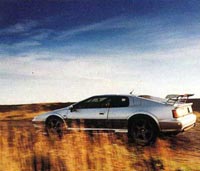
ELITELOTUS
Lotus Esprit 350
They've lopped another 80kg off the Esprit, and added a carbonfibre tea-tray on the back, huge magnesium wheels, beefed up brakes and a brilliant cockpit. Is it, therefore, the best Esprit ever? story by Paul Horrell.
The new Esprit Sport 350 has the lightest magnesium wheels obtainable. It has a rear wing developed for a track car, made of carbonfibre, sitting on milled aluminium pylons. It has two-piece racing brakes discs. It has firmer suspension then ever. It also has — and this is a first in my experience — colour-coded loudspeaker cones, little circles of blue visible through the grilles at either end of the dash-top that exactly match the shade of paint on the AP Racing brake caliperss. This may be the most extreme and sporting Esprit ever, but that didn't stop Lotus having a few little visual larks on the side.
Let's see now. In the past 3 years I've driven about nine Esprits, and I think they were of six different types. Lotus builds nearly as many new Esprit models as it builds Esprits. But the Norfolk toaster has always found a steady stream of fans, people who are so into the car they never consider anything else.

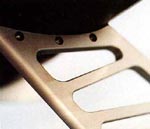
Even if the Esprit remains a painfully hard car to get into — and even harder one to get out of, thanks to high sills, far-back door posts and a handbrake that keeps making pre-emptive strikes on your lower calf.
Once you're in, though, the best-ever Esprit interior wraps itself around you. There's the facelift dashboard introduced a year back, which brought to the Esprit the novelty of instruments you can actually read. In this version the binnacle top is carbonfibre. Not the fake stuff but real woven black compositee, hard and tinny to the touch, a fineweave plaid mirage that reflects, glinting but not distracting, in the windscreen. Much of the centre console is the same, and the instruments are set in aluminium sheet. The gearknob is solid aluminium, too. All this garnish of lightweight materials certainly makes the thing feel like a race car, but probably saves the weight of one packet of Cheesy Wotsits. The strip-out doesn't run as far as losing the air-con, mind, which is good. Given the way that vast near-horizontal plate-glass windscreen mists up without it, air-conditioning makes the Esprit several hundred percent faster.
A car with 350bhp has every chance of being very fast indeed, and the Esprit's twin-turbo V8 has never disappointed in its mad speed-junkie thrust. The version in question gets colour-coded blue inlet manifold and cam covers, but the engine internals and power output are standard. Only the throttle response has been sharpened by re-programming the ECU. So the chip, justifiably, could be painted blue.
It's down to the weight reduction, a worthwhile 80kg over the usual V8, to boost acceleration. Lotus claimss 4.6 seconds to 62mph and 10.1 to 100 (from rest) shattering numberss that talk of a step-off that makes if feel like the floor has given way beneath you, and high-speed acceleration to fire other traffic away behind you like a volley of cannonballs.
The rest of the car's mods are designed to help you enjoy the speed more. The rear half of the chassis frame is made more rigid in the engine area, and that has allowed the stiffest-ever suspension settings on a road Esprit, sharpening up the corning on what is already one of the sharpest supercars of all.
Unsprung weight is shaved by those mag wheels and alloy bell-mounts for the (larger) discs, and the brakes themselves use AP Racing calipers, fed by the standard ABS. Tyres are Pirelli P-Zero in a super-sticky compound. Apparently Lotus was a bit stung when the press said the V8 didn't have enough rear-end grip. Fitting 295/35 ZR18 P-Zeros certainly sounds like a reasonably thorough solution.
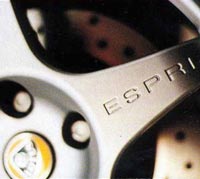
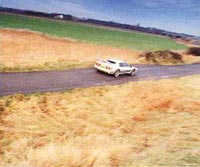
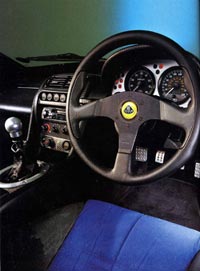
And yet, and yet. I've collected the Sport 350. It's midnight. It's raining. I'm in a particulary grimy part of London and every heavy vehicle in the borough has been spreading the roads with a black mayonnaise of clag. Pulling out of junctions, exiting from roundabouts — doing anything, really, that isn't a straight and level 25mph — demands a radical driver recalibration. You have to treat the accelerator (aluminium, drilled, natch) like a piece of glass embedded with nails that has an unexploded grenade jammed beneath it. When the turbos spool up, at about 2000rpm, those huge tyres simply go sledging, spinning like catherine wheels — which only gives the engine more revs, and with it more boost, and so yet more revs. Trouble is, when you try and stay off-boost the clutch snatches and the engine likes nother more than to turn around, thumb its nose at you, and stall. And out on an urban dual carriageway you find it'll spin its rear tyres clear through most of the gears. When they're not screaming, those tyres drum like there's cement being mixed inside your skull. OK, you can use an Esprit for everyday journeys, but it's seriously sub-optional. Lotus has delivered a product with fully benchmarked cussedness and best-in-class aggro.
It's easy picking through the Esprit's supercar-cliche faults. Releasing the handbrake is like tying your shoelaces with your seltbelt on. If you're tall you won't fit anyway. The cabin fittings twitter like the queue for a Boyzone gig. The sticky gearbox and lousy over-shoulder vision mean a lunar landing is less of a daunting adventure than a three-point turn. But you will never, never find anything on this car that is as bad as its steering is good.
Few things are more important on a car this fast than the direction-finding mechanism, and the Sport 350's steering is little short of miraculous. Gearing and weighting and accuracy are spot-on. But that's hardly rockect science. The Momo wheel itself is the very thing, but you can buy that for a couple of hundred quid. The GT350's stering hoists itself onto another orbit with the impossible absence of compromises. It suffers hardly at all from kickback or deflection on bumps and ridges, and yet the feel is deliciously natural and intimate: every little squirm of the front treads is passed up as a change in weighting to your hands, a little wriggle of the steering wheel's rim. You can drive the car with glorious accuracy, which is nice; you can also drive it with marvellous confidence about the state of grip, which is much more than nice.
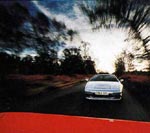
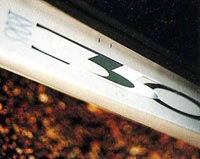
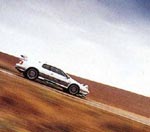
It's all very fine knowing just what the front wheels are up to, but it would be a bit academic if the other half of the car is staggering about like a drunk in the dark, unlikely to go straight, unable to communicate. Not here. Despite the tyres' scary hugeness and the overwhelming twin-turbo V8, the dark satanic forces clashing behind you, there's a sweetness to the whole operation that keeps your mouth moist and your palms dry. On a smooth, dry road the grip and traction are phenomenal; when it's wet or bumpy it releases its hold progresssively like no other mid-engined supercar.
The firm springs on the Sport 350 make it even sweeter and more precise on a smooth road than your standard-issue Esprit, but its gets shaken up more by a bad stretch, which slows you up. That wonderful Lotus suppleness isn't so evident here. Mind you, we're talking relatives. This car is made in Norfolk, where the roadmenders live a long way apart. In absolute measures, it copes well.
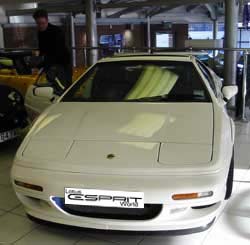
You have to get up very early in the morning to find a car that makes the Esprit seem slow. Once you're properly rolling, there's always boost up for grabs. The phrase 'controlled explosion' comes to mind. The first time you really press the accelerator it's like setting off a fire extinguisher; something a bit irrevocable, a bit more than you bargained for. In truth, it can be controlled, modulated and regulated as you want, but there's not the precision of a big naturally aspirated engine. Instead, there's the feeling you're reeling something in, rather than paying it out. How far does this torrent go? Not sure, to tell you the truth. There's no red line and anyway the boost tails off a little beyond 5500 revs, so I tended to change up and surf away again.
Besides, there's little ear-candy to be found at high revs. The Lotus V8 has never sounded too pukka. There's an optional sports exhaust you buy from Lotus's aftermarket catalogue, but this box-fresh Sport 350 did without. No, the compelling thing about this engin is the almost off-hand way it tosses out such a colossal rush. That and the way you can work the acceleration, meld it into cornering and braking that are just as brutal but smooth and perfectly under your control.
Obviously the Sport 350 makes you pay for your pleasure — arguably, it goes some way beyond the concept of mere pleasure. But it is a wretchedly inconvenient car, and ownership demands of you the sum of one arm and one leg: £64,950 is £5,000 more than the standard V8. Mind you, it's but two-thirds the price of Mr Ferrari's cheapest.
This is, no question, the best Esprit ever, as well as the dearest of all the variants. We shouldn't be too surprised at the evolution, though, since the current-shape car saw the light in 1987. During those years Porsche has been building four entirely different generations of 911, and over at Ferrari the 328 has become the 348 has become the F355 (itself to be replaced by the 360). So Lotus has had some developing to do.
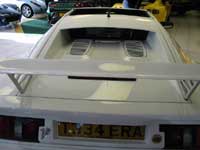
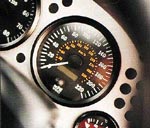
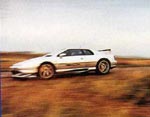
|
|